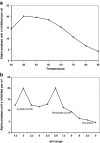Purification of a novel α-amylase inhibitor from local Himalayan bean (Phaseolus vulgaris) seeds with activity towards bruchid pests and human salivary amylase
- PMID: 24966421
- PMCID: PMC4062694
- DOI: 10.1007/s13197-012-0631-1
Purification of a novel α-amylase inhibitor from local Himalayan bean (Phaseolus vulgaris) seeds with activity towards bruchid pests and human salivary amylase
Abstract
Six bean (Phaseolus vulgaris L.) cultivars of Himalayan region were analysed for α- amylase inhibitor activity. The α-amylase inhibitor from seeds of screened bean cultivar KR-9, showing maximum inhibitory activity was purified using ammonium sulfate precipitation, gel filtration chromatography (Sephadex G-100) and ion exchange chromatography (DEAE-Sephadex). The inhibitor was purified to homogeneity as judged by native-PAGE with 14.22 fold purification and 71.66% recovery. Purified inhibitor consisted of three subunits of molecular weight 15,488, 18,620 and 26,302 daltons, respectively as determined by SDS-PAGE. It was found to be heat stable up to 30 °C-40 °C and had two pH optima of 5.0 and 6.9. Nature of inhibition was found to be of non-competitive type. The purified inhibitor was found to be effective against α-amylases extracted from larvae of Callosobruchus chinensis, Tribolium castaneum and gut enzyme of Spodoptera littoralis. Larvae of Tribolium castaneum fed on flour mixed with purified inhibitor for 5 days showed 100% larval mortality. Purified α-amylase inhibitor was also found to inhibit human salivary α-amylase, suggesting its potential in prevention and therapy of obesity and use as drug design targets for treatment of diabetes. The gene encoding the inhibitor may be used to develop transgenic plants resistant against insect pests.
Keywords: Callosobruchus chinensis; Phaseolus vulgaris; Spodoptera littoralis and Human salivary amylase; Tribolium castaneum; α-Amylase inhibitor.
Figures



Similar articles
-
Purification and characterization of α-amylase from Acanthoscelides obtectus (Say) (Coleoptera: Chrysomelidae).Int J Biol Macromol. 2024 Oct;278(Pt 4):135009. doi: 10.1016/j.ijbiomac.2024.135009. Epub 2024 Aug 22. Int J Biol Macromol. 2024. PMID: 39181371
-
Insecticidal activity of an alpha-amylase inhibitor-like protein resembling a putative precursor of alpha-amylase inhibitor in the common bean, Phaseolus vulgaris L.Biochim Biophys Acta. 1999 Jun 15;1432(1):104-12. doi: 10.1016/s0167-4838(99)00093-x. Biochim Biophys Acta. 1999. PMID: 10366733
-
A glycoprotein α-amylase inhibitor from Withania somnifera differentially inhibits various α-amylases and affects the growth and development of Tribolium castaneum.Pest Manag Sci. 2017 Jul;73(7):1382-1390. doi: 10.1002/ps.4467. Epub 2016 Dec 26. Pest Manag Sci. 2017. PMID: 27770482
-
Evaluation of inhibitory activity, purification and X-ray crystallography of Alpha-Amylase inhibitor from Phaseolus vulgaris cultivars of Uttarakhand, India.Braz J Biol. 2022 Oct 10;84:e253180. doi: 10.1590/1519-6984.253180. eCollection 2022. Braz J Biol. 2022. PMID: 36228224
-
Common bean (Phaseolus vulgaris L.) α-amylase inhibitors as safe nutraceutical strategy against diabetes and obesity: An update review.Phytother Res. 2022 Jul;36(7):2803-2823. doi: 10.1002/ptr.7480. Epub 2022 Apr 29. Phytother Res. 2022. PMID: 35485365 Free PMC article. Review.
Cited by
-
Bruchid beetle ovipositioning mediated defense responses in black gram pods.BMC Plant Biol. 2021 Jan 11;21(1):38. doi: 10.1186/s12870-020-02796-4. BMC Plant Biol. 2021. PMID: 33430784 Free PMC article.
-
Diversity of transgenes in sustainable management of insect pests.Transgenic Res. 2023 Oct;32(5):351-381. doi: 10.1007/s11248-023-00362-w. Epub 2023 Aug 12. Transgenic Res. 2023. PMID: 37573273 Review.
-
Purification and Characterization of Proteinaceous Thermostable α-Amylase Inhibitor from Sardinian Common Bean Nieddone Cultivar (Phaseolus vulgaris L.).Plants (Basel). 2024 Jul 26;13(15):2074. doi: 10.3390/plants13152074. Plants (Basel). 2024. PMID: 39124191 Free PMC article.
-
Effects of Phaseolus vulgaris Extract on Lipolytic Activity and Differentiation of 3T3-L1 Preadipocytes into Mature Adipocytes: A Strategy to Prevent Obesity.J Nutr Metab. 2019 Apr 28;2019:5093654. doi: 10.1155/2019/5093654. eCollection 2019. J Nutr Metab. 2019. PMID: 31183217 Free PMC article.
-
Biochemical Properties of α-Amylase from Midgut of Alphitobius diaperinus (Panzer) (Coleoptera: Tenebrionidae) Larvae.Neotrop Entomol. 2018 Oct;47(5):698-708. doi: 10.1007/s13744-018-0590-y. Epub 2018 Feb 26. Neotrop Entomol. 2018. PMID: 29484545
References
-
- Bernfeld P. Amylases, α and β. In: Colowick SP, Kalpan NO, editors. Methods in enzymology. New York: Academic; 1955. pp. 149–158.
-
- Bonavides KB, Pelegrini PB, Laumann RA, Grossi-de-Sa MF, Bloch JC, Melo JA, Quirino BF, Noronha EF, Franco OL. Molecular identification of four different α-amylase inhibitors from baru (Dipteryx alata) seeds with activity toward insect enzymes. J Biochem Mol Biol. 2007;40:494–500. doi: 10.5483/BMBRep.2007.40.4.494. - DOI - PubMed
-
- De Sousa-Majer MJ, Hardie DC, Turner NC, Higgins TJV (2007) Bean α-amylase inhibitors in transgenic peas inhibit development of pea weevil larvae. J Econ Entomol 189:1416–1422 - PubMed
LinkOut - more resources
Full Text Sources
